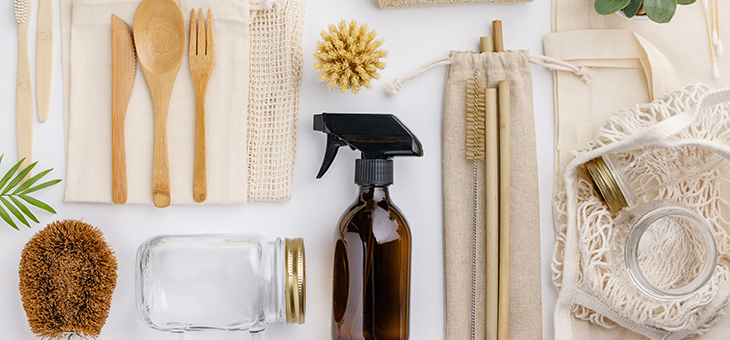2020 has been a big year when it comes to plastic. So many more of us are now finally trying to use less, recycle more and just generally think about the planet. And it’s high time. But there’s always at least one extra change you can make.
“We believe that simple swaps, from plastic to paper and cardboard alternatives, could significantly reduce single-use plastic, says Alex Manisty, group head of strategy at DS Smith, a sustainable packaging company. “While there is no silver bullet, sustainable packaging has a huge role to play and – unlike plastic – paper and cardboard are materials that are recyclable not just in theory but in practice, achieving recycling rates of 85 per cent today across Europe.”
So, how can you do more? Try making these easy eco swaps at home.
1. Keep food fresh without using cling wrap
Beeswax wraps are all the rage at the moment, which can make them pricey. Use this tutorial to make your own at home.
Or if that’s too much like hard work, pop to your local farmers’ market to buy some. Reusable beeswax wraps are an excellent alternative to plastic cling wrap and ziplock bags. Wrap up cut up fruit and vegies, sandwiches and rolls, and cover plates and bowls just like you would with cling wrap.
2. Only use recyclable wrapping paper
Most of us are aware you can’t recycle all wrapping paper, but we often throw it in with the paper waste and hope for the best.
Non-paper gift wrap, such as foil-based wrapping paper or bags, cannot be recycled. You can check if your wrap can be recycled by scrunching it; if it springs back when you scrunch it, it’s not recyclable. Just buy lovely brown paper and decorate presents with ribbons or string, which can also be reused. When you are recycling wrap, remember to remove any bits with labels or tape on them, too.
3. Put your recycling in the right bin
It sounds obvious, but so many people put items in the wrong recycling bins. This Christmas, more than 90 per cent of us are set to shop online, which, according to DS Smith, means that 25 per cent more cardboard will make its way into residential collections. To make sure that all recyclable paper and cardboard is actually sent for recycling, residents need to make sure that it ends up in the correct recycling bin.
4. Bin the bubble wrap
Bubble wrap and plastic-lined envelopes are extremely difficult to recycle, so use paper versions instead. They’ll protect any goodies you’re popping in the post and can then be recycled.
5. Use a good old hankie
Tissues, paper towels and kitchen roll cannot be recycled once used – mainly for hygiene reasons. So why not go old school and swap these for a handkerchief or cloth, so you can wash them and reuse?
6. Treat yourself to a reusable coffee cup
If you frequent your local cafe for your morning caffeine fix, maybe it’s time to get yourself a reusable coffee cup. It is estimated Australians use one billion disposable coffee cups each year. That’s approximately 2,700,000 paper coffee cups thrown out every day.
The greenest choice is to bring along your own reusable cup. Some outlets offer a discount for bringing your own reusable cup. Bringing your own cup could save you around 50c on your coffee.
7. Don’t forget to recycle your pizza boxes
Pizza boxes are 100 per cent recyclable, even when greasy, as long as there is no food left in them and they aren’t heavily stained. The best way of ensuring your pizza box can be recycled is to remove any crusts, leftover food, and soak up any excess oil.
8. Think about the cards you buy
Greetings cards can be recycled, as long as they’re not covered in glitter or other non-paper materials, so only buy ones you can actually recycle.
9. Stop buying records and CDs
I know, I know, we love vinyl too, but do you really need any more stuff cluttering up your home? Sign up to a music streaming service and invest in a bluetooth speaker. That way, you can select and play pretty much any song you fancy listening to in seconds.
10. Shop with recyclability in mind
In 2018, the Australian Packaging Covenant Organisation (APCO) launched the Australasian Recycling Label to overcome the confusion consumers face over knowing what to recycle. Although not every product carries this label yet, look for it and follow the advice it offers. If you really want to start making changes, avoid foods packaged in single-use plastics.
Find out more about the Australasian Recycling Label and what to look for here.
How much do you recycle at home? Do you have a reusable coffee cup or water bottle? Do you check recycling labels before you buy?
– With PA
If you enjoy our content, don’t keep it to yourself. Share our free eNews with your friends and encourage them to sign up.
Related articles:
https://www.yourlifechoices.com.au/government/federal-government/grim-environmental-scorecard/
https://www.yourlifechoices.com.au/recycling-crisis-begins-with-us/
https://www.yourlifechoices.com.au/lifestyle/news/the-plastic-in-our-oceans/

